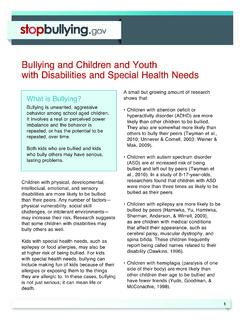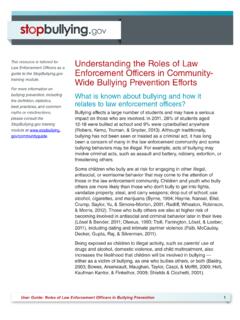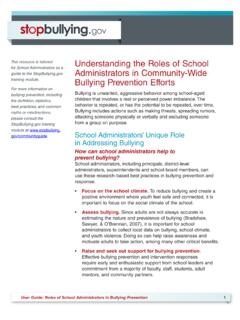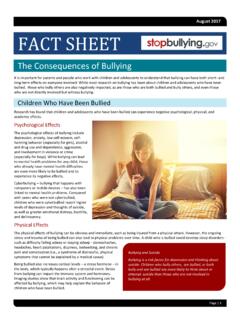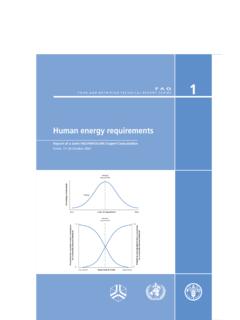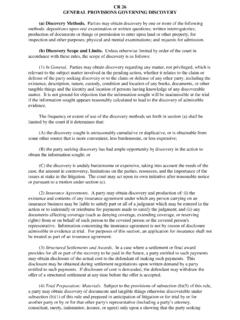Transcription of Bullying Prevention & Response Base Training Module
1 1 2 Welcome to today s Bullying Prevention and Response Training . As you know, Bullying is a serious problem affecting youth in communities all across America, and all adults have a role in helping to stop it. We have gathered for this Training so that each individual in this room has a better understanding of Bullying and is equipped with the tools and resources to take action.
2 Specifically, this Training provides you with guidance to hold a community event such as a town hall meeting to activate your community in Bullying Prevention . When you leave here today, our goal is to successfully communicate: The definition of Bullying , the many forms it takes, and its effects Best practices in preventing Bullying and responding when you see Bullying happen Compelling examples of what works How to create an action plan and execute your community event We will also provide you with a Community Action Toolkit that offers guidance and research based resources to make it as easy as possible to get started and make a difference. You will notice that many of the resources have been tailored for our profession and the work that we do. During this Training , you will become familiar with many of the resources developed by the Federal Partners in Bullying Prevention , representing leaders in the federal government working together to make sure communities have what they need to combat Bullying .
3 3 This project was funded by the Department of Health and Human Services (HHS), Health Resources and Services Administration (HRSA). Let s begin our Training by reviewing the definition of Bullying . 3 Our goal is to successfully communicate the following, so that you leave here today prepared to: Define Bullying , the many forms it takes, and its effects Discuss best practices in Bullying Prevention and responding to Bullying that occurs Highlight compelling examples of strategies that work Create an action plan and execute your community event 4 5 This is the full definition of Bullying from : Bullying is unwanted, aggressive behavior among school aged children that involves a real or perceived power imbalance.
4 The behavior is repeated or has the potential to be repeated, over time. Both kids who are bullied and who bully others may have serious, lasting problems. In order to be considered Bullying , the behavior must be aggressive and include: An Imbalance of Power: Kids who bully use their power such as physical strength, access to embarrassing information, or popularity to control or harm others. Power imbalances can change over time and in different situations, even if they involve the same people. Repetition: Bullying behaviors happen more than once or have the potential to happen more than once. Bullying includes actions such as making threats, spreading rumors, attacking someone physically or verbally, and excluding someone from a group on purpose. 6 Researchers, practitioners, and policymakers face a number of challenges in defining Bullying and knowing how to identify it.
5 Let me highlight some of these challenges briefly and then come back to discuss them in more detail. A first challenge has to do with identifying often on the spot if behavior that occurs in a school s hallways, cafeteria, or on a playground is aggressive or if it is rough in fun. A second challenge involves the repetitive nature of Bullying . What makes something repetitive? And can a behavior be considered Bullying if it occurs only once? A third challenge is understanding what counts as a power imbalance among children. 7 Let s look at that first challenge.
6 How can we determine if a behavior is Bullying or simply rough play, which is common, particularly among younger boys? As mentioned earlier, an important step in defining Bullying is that it must be unwanted aggressive behavior which is often defined as the intentional use of harmful behaviors against another child. These behaviors may be threatened or real. How can we tell on the playground or in the hallways if behavior is actually aggressive, or if it s just play ? We can t always rely on children to tell us what s really going on, since children who bully may often explain their behavior as just messing around or all in fun. Rather, we have to look for cues to help such as how the children involved relate to each other: Are they long standing friends or do they have a history of issues between them? What are their expressions and body language? Does it look like both are having fun, or is one showing obvious or subtle signs of distress?
7 When in doubt, it is important to follow up especially if you don t know the children well. And of course, even if a behavior you observe isn t Bullying , it still may not be acceptable in a school or other setting. 8 Bullied children typically experience multiple incidents or a pattern of aggression against them. But according to the CDC, Bullying also may exist if there is a high likelihood that the behavior will be repeated. Just because Bullying typically is repeated over time doesn t mean that a one time instance isn t Bullying or that adults should wait for a pattern to emerge before responding. 9 Power imbalances can be characterized by physical differences between children, such as age, size, and strength.
8 But they need not be physical. Power can also be characterized by: Popularity Background/demographic characteristics (such as whether or not a child is a member of a majority racial or ethnic group, whether he or she has a high socio economic status, whether he is in the majority regarding sexual orientation) By social, academic, physical or other skills or abilities Or by access to money, resources, or information such as being able to reach an entire student body with a single e mail button One also can exert power over others by outnumbering them (for example, having a group of friends join in the Bullying of a single child) or by having a weapon. 10 There is also sometimes confusion over what happens when Bullying behaviors cross a legal line.
9 Some Bullying behaviors may also meet the legal definition of harassment or assault. Remember though, not all incidents of harassment or assault are Bullying , and not all Bullying involves harassment or assault. The US Department of Education s Office for Civil Rights issued a Dear Colleague (DCL) letter on harassment and Bullying in late October 2010. You can access the full letter on We will discuss this issue more in depth later in the presentation. Now let s take a close look at some cases of harassment that are illegal under federal law. The DCL highlights that discriminatory harassment may include harassment or Bullying that is grounded in race, color, national origin, sex, or disabilities. Current laws do not protect against harassment based on religion or sexual orientation, but they do include protection against harassment of members of religious groups based on shared ethnic characteristics as well as sexual harassment of LGBT individuals.
10 The message to school personnel is that they must carefully consider whether Bullying behavior is discriminatory harassment that violates students federal civil rights. Under federal law, school personnel have very clear obligations to investigate immediately in such circumstances and to take prompt steps to end the harassment if it occurred. 11 12 13 14 The internet and electronic devices have provided a new context in which Bullying can occur.


